Continence Assessment Form and Care Plan RESIDENT ID 1
Continence Assessment Form and Care Plan RESIDENT ID 1
Continence Assessment Form and Care Plan RESIDENT ID 1
Create successful ePaper yourself
Turn your PDF publications into a flip-book with our unique Google optimized e-Paper software.
SECTION C: Nutrition (fluid & diet)<br />
Best practice recommendations<br />
■■<br />
■■<br />
Aim for the resident to have 5-10 cups of fluid per day unless otherwise indicated & limit known bladder irritants (i.e. coffee, alcohol)<br />
Aim for the resident to have 30gm of dietary fibre per day unless otherwise indicated<br />
<strong>Assessment</strong> Cues<br />
(tick appropriate response)<br />
20. Does the resident drink an adequate<br />
amount of fluid to maintain hydration<br />
<strong>and</strong> healthy bladder <strong>and</strong> bowel function?<br />
(Refer to 3-day bladder chart <strong>and</strong> check<br />
colour of urine)<br />
■ Yes<br />
■ Sometimes<br />
■ No<br />
21. Does the resident eat an adequate<br />
amount of food with fibrous content<br />
to maintain healthy bladder <strong>and</strong><br />
bowel function? (Refer to nutritional<br />
assessment)<br />
■ Yes<br />
■ Sometimes<br />
■ No<br />
<strong>Care</strong> Options<br />
(tick appropriate care option)<br />
If sometimes or no:<br />
■ Encourage resident to drink _________ cups of ______________ per day.<br />
■ Monitor <strong>and</strong> report underhydration (under 5 cups per day & dark coloured urine).<br />
■ Monitor <strong>and</strong> report excessive drinking (over 10 cups per day).<br />
■ Monitor urine colour (if concerned about dehydration).<br />
If sometimes or no:<br />
■ Refer to resident’s nutritional care plan.<br />
■ Encourage the resident to eat cereals, vegetables <strong>and</strong> fruit regularly.<br />
■ Offer small snacks regularly.<br />
■ Refer to nutritional/swallowing assessment <strong>and</strong> care plan.<br />
■ Ensure dentures are in at meal times <strong>and</strong> that they fit.<br />
SECTION D: Skin care<br />
Best practice recommendations<br />
■■<br />
Aim for the resident’s skin to remain intact <strong>and</strong> free from rashes, excoriation <strong>and</strong> pressure ulcers<br />
<strong>Assessment</strong> Cues<br />
(tick appropriate response)<br />
22. Does the resident’s skin around<br />
their buttocks, groin <strong>and</strong> perineal area<br />
appear to:<br />
■ Be very thin or fragile<br />
■ Be reddened<br />
■ Be unusually pale<br />
■ Have a discharge<br />
■ Have a foul or bad smell<br />
■ Be broken, have a rash or have<br />
lumps <strong>and</strong> blotches<br />
■ Other (specify) _____________<br />
_ ____________________________<br />
23. Is the resident currently using a<br />
continence product to contain their<br />
incontinence?<br />
■ Yes – during day <strong>and</strong> night<br />
■ Yes – during day only<br />
■ Yes – during night only<br />
■ No<br />
<strong>Care</strong> Options<br />
(tick appropriate care option)<br />
If yes to any skin abnormalities, consider the general care options below <strong>and</strong><br />
ask the RN, <strong>Continence</strong> Nurse <strong>and</strong>/or GP about the care required.<br />
■ Change wet pads, linen <strong>and</strong> clothing soon after incontinent episodes.<br />
■ Use the wetness indicators on disposable continence pads as a guide to know when to change<br />
the pad.<br />
■ Use a non- irritating, pH neutral product for washing the skin after each incontinent episode.<br />
■ Use a soft toilet paper or ‘wet ones’ for wiping if skin is very sensitive.<br />
■ Apply a barrier cream for protection against exposure to urine <strong>and</strong>/or faeces<br />
If yes, select a<br />
product that is<br />
able to absorb<br />
the volume of<br />
urine loss <strong>and</strong>/<br />
or contain the<br />
faecal matter <strong>and</strong><br />
is comfortable for<br />
the resident.<br />
Select from the following options:<br />
Day<br />
Night<br />
■ Disposable pad ■ (type)_ ____________ ■ (type) _ _____________<br />
■ Washable pad/pant ■ (type)_ ____________ ■ (type) ______________<br />
■ Commode ■ ■<br />
■ Condom drainage ■ ■<br />
Developed by Deakin University <strong>and</strong> funded under the National <strong>Continence</strong> Management Strategy<br />
5




